
13. Catalysis of Diels–Alder reactions in water |
1049 |
suggest that sometimes the Cope rearrangement does not occur and that it should be possible to isolate the [2 C 4] adduct108. In a similar way the hetero-Diels–Alder reactions of azadienes113, sulphur dioxide114 and nitrosoethylene115 were investigated in great detail116. These examples demonstrate the far-reaching power of computational chemistry methods in elucidating reaction mechanisms.
The Diels–Alder reaction of enantiomerically pure chiral acrylic esters with cyclopentadiene leads to a pair of diastereomers. Their ratio depends strongly on the choice and amount of Lewis acid catalyst (Scheme 8)117. While titanium tetrachloride leads preferentially to the (2R)-diastereomer with high selectivity, ethyl aluminium dichloride gives the (2S)-diastereomer in only 56% de.
The dependence of the diastereomeric ratio on the choice of Lewis acid can be understood when considering the geometry of the Lewis acid complex. In the case of the titanium tetrachloride catalysed reaction, the interaction of the ester and the catalyst is strongly supported by the first crystal structure observed of the Lewis acid with a chiral dienophile (Figure 4)118.
The activation of various reactions by Lewis acids is now an everyday practice in synthetic organic chemistry. In contrast, solvent effects on Lewis acid catalysed Diels –Alder reactions have received much less attention. A change in the solvent can affect the association step leading to the transition structure. Ab initio calculations on the Diels–Alder reaction of cyclopentadiene and methyl vinyl ketone in aqueous media showed that there is a complex of the reactants which also involves one water molecule119. In an extreme case solvents can even impede catalysis120. The use of inert solvents such as dichloromethane and chloroform for synthetic applications of Lewis acid catalysed Diels–Alder reactions is thus well justified. General solvent effects, in particular those of water, will be discussed in the following section.
B. Solvent Effects on Diels–Alder Reactions
Solvent effects on the reactivities and selectivities of organic reactions are intricate combinations of non-covalent interactions. Generally, these are separated into hydrogen bonding, hydrophobic interactions and electrostatic effects. In a typical approach, a property of a reaction, such as its rate or selectivity, is measured in a number of different solvents. This procedure allows the comparison of solvent properties and their effects on reaction rates as well as selectivities, and other observable parameters. Correlating the characteristics of a particular reaction with one or more solvent parameters reveals which non-covalent interactions are important. The major drawback is, however, that solvent parameters are often not independent. Here also, theoretical models and computer simulations provided valuable additional insights121. Both methods, the experimental dissection of the solvent effects and the computational models, have been applied successfully to Diels –Alder reactions. In the following we will attempt to generalize the results of these studies. We will discuss separately the interactions which lead to rate accelerations and increased selectivities.
At first glance the Diels–Alder reaction represents an organic transformation which is relatively insensitive to solvent effects (Table 9). For the dimerization of cyclopentadiene, the second-order rate constants in a broad range of organic solvents are quite similar5. The data of Table 9 refer to the special case of a Diels–Alder reaction between two pure hydrocarbons. Usually, Diels –Alder reactions only proceed at an appreciable rate when either the diene or the dienophile is activated by electron-donating or electron-withdrawing

1050
|
|
|
|
|
|
|
−63°C, 0.7 eq. TiCl4 |
|
7 |
: |
93 |
|
|
|
|
|
|
|
|
CH2Cl2/n-C6H14 (1:1) |
|
||||
|
|
|
|
|
|
|
|
|
|
|
||
H |
|
O |
|
|
2 |
|
|
|
||||
|
|
|
H3C |
H |
|
|
||||||
|
|
|
|
|
|
|
|
|
|
|
||
|
|
|
|
|
|
|
|
|
|
+ |
H3C |
H |
H3C |
|
+ |
|
|
|
|
||||||
|
|
|
|
|
|
|||||||
O |
|
|
O |
O |
COOEt |
2 |
|
|||||
EtOOC |
|
|
|
|
|
|
|
|||||
|
|
|
|
|
|
|
|
|
||||
|
|
|
|
|
|
|
|
|
|
|
|
|
|
|
|
|
|
|
|
|
|
(2S) |
O |
O |
COOEt |
|
|
|
|
|
|
|
|
|
||||
|
|
|
|
|
|
|
|
|
|
(2R) |
|
|
|
|
|
|
|
|
|
|
|
|
|
|
|
|
|
|
|
|
|
|
−63°C, 2.5 eq. EtAlCl3 |
|
78 |
: |
22 |
|
|
|
|
|
|
|
|
CH2Cl2 |
|
||||
|
|
|
|
|
|
|
|
|
||||
|
|
|
|
|
|
|
|
|
|
|
||
SCHEME 8. Stereodichotomy of the Lewis acid catalysed Diels – Alder reactions of a chiral acrylic ester and cyclopentadiene
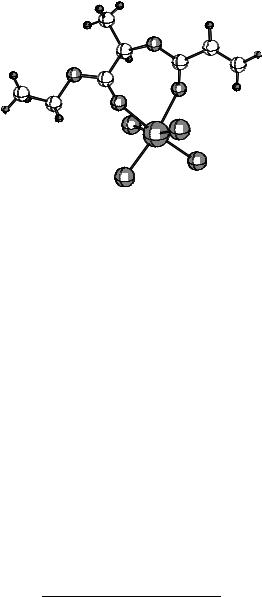
13. Catalysis of Diels–Alder reactions in water |
1051 |
|||||
|
|
C |
|
|
|
|
|
|
C |
O |
|
C |
|
|
|
|
|
|
||
|
|
|
|
|
|
|
|
|
|
|
C |
C |
|
|
|
|
|
|
|
|
|
O |
C |
|
|
|
|
|
|
|
|
|
|
|
C |
|
|
|
O |
|
|
|
|
|
|
|
|
|
C |
|
O |
|
|
|
|
|
|
|
Cl |
Cl |
|
|
|
|
|
Ti |
|
|
|
|
|
|
|
|
|
|
|
|
|
|
|
Cl |
|
|
|
Cl |
|
|
|
|
FIGURE 4. The crystal structure of the Lewis acid complex of a chiral dienophile with titanium tetrachloride118
substituents which mostly contain heteroatoms. These can interact efficiently with the solvent, resulting in an amplification of the solvent effect on the reaction.
There are numerous attempts to correlate solvent parameters with the reaction rate of Diels –Alder reactions122. Examples are the Brownstein Polarity Parameter S123, the Solvophobicity Parameter Sp124,125 the D – parameter (based on the solvent effect on the reaction of tetracyanoethylene and diazodiphenylmethane with benzene as the reference solvent)126 or the Acceptor Number AN127,128 (a parameter which describes the ability of a solvent to act as an electron pair acceptor)129. These examples included either reactions that were next to insensitive to solvent effects (like that in Table 9) or reactions in which the reactants mainly interact with the electron pair on the donor atom of the solvent130.
These results led to a separation of the observed Diels –Alder reactivities into three categories: (a) increase of the rate constants on increasing the Lewis acid character of the solvent as quantified by the AN parameter; this behaviour reflects the interactions between the LUMO of the solvent and the HOMO of the reactants and is similar to Lewis acid catalysis (vide supra); (b) reaction retardation by electron donation, as quantified by the
D – parameter; the HOMOsolvent –LUMOreactant interactions are held responsible for this effect, representing an ‘anti-Lewis acid’ interaction which increases the HOMO–LUMO
gap and hence hampers the reaction; (c) the Diels–Alder reactions show very small solvent effects and are relatively insensitive to specific reactant –solvent interactions, and
TABLE 9. Second-order rate constants k for the dimerization of cyclopentadiene in the gas phase and in several solvents at 25°C5
Solvent/state |
k M 1 s 1 |
Gas phase |
6.9 ð 10 7 |
Neat |
5.6 ð 10 7 |
CCl4 |
7.9 ð 10 7 |
PhNO2 |
13 ð 10 7 |
EtOH |
19 ð 10 7 |
1052 |
Alexander Wittkopp and Peter R. Schreiner |
the dimerization of cyclopentadiene is a typical example (Table 9). To our knowledge, pure water or mixtures of water with other solvents were not examined131.
In studies on Diels –Alder reactions of type (a) in which only organic solvents were used, the rate constants correlate well with the solvent hydrogen-bond donating capacity ˛106. For the methyl acrylate/cyclopentadiene reaction, log k, the logarithm of the rate constant in a number of solvents, correlates linearly with ˛. In mixtures of water with acetone or 1,4-dioxane, log k gave a linear correlation with the solvophobicity parameter Sp132. In studies including mixtures of water and several organic solvents, an empirical combination of Sp and the ENT [a normalized ET (30) parameter] scale5 allowed the calcu-
lation of rate constants leading to excellent agreement with observed rate constants133,134. The rates of Diels–Alder reactions in highly viscous media were correlated with solvent density and were ascribed to internal pressure effects135,136. These empirical correlations can only be generalized within narrow bounds. It should be noted that analysis of the interplay between a specific organic reaction and the physical properties of the solvents is not easy. Even the effects of apparently simple solvent systems like a 5 M solution of lithium perchlorate in diethyl ether lead to controversy137 –139. Diels –Alder reactions in such media are accelerated and rationalizations from internal pressure effects138,140 to Lewis acid catalysis by the lithium cation had been advanced137,139. It was suggested that only if Diels–Alder reactions are not sensitive to Lewis acid catalysis, internal pressure and similarly weak effects can explain the very modest accelerations141. If there are several catalytic effects, Lewis acid catalysis is most effective. Combining Lewis acid catalysis with the use of water as a solvent seems therefore a worthwhile undertaking. The results available to date will be presented in the following.
Solvents and additives can influence Diels –Alder reactions through a multitude of different interactions, of which the contributions to the overall rate depend uniquely on the particular solvent –diene–dienophile combination. Attempts to build a general picture are limited to the most extensively studied type (a) Diels –Alder reactions. These Diels–Alder reactions are dominated by hydrogen-bonding and solvophobic interactions. This observation predicts a very special role of water as a solvent for type (a) Diels –Alder reactions.
The influence of the solvent on the regioselectivity is perfectly described by FMO theory142. As mentioned above, the regioselectivity is determined by orbital coefficients on the terminal carbons of the diene and dienophile which, in turn, are determined by the electronic substituent effects. These can be modified by electron donation or electron withdrawal by the solvent or additives like Lewis acids.
Changing the electron distribution through the solvent can be achieved efficiently by hydrogen bonding. This has become apparent from multiparameter analyses of the solvent effects on the regioselectivities, which revealed a dominant contribution of the hydrogenbond donating character of the solvent143. Apart from that, solvent effects on the endo/exo ratio of Diels –Alder reactions were interpreted in terms of different polarities of the individual Lewis acid–base complexes involved144. In general, the endo-transition structure is of higher polarity than the exo-transition structure because the dipole moments in the endo-complex of the diene and dienophile are aligned, whereas in the latter they are pointing in opposite directions (Figure 5).
This explains the experimentally confirmed predictions that polar solvents attenuate the endo-preference, while non-polar solvents increase the endo-selectivity of Diels–Alder reactions. The strong correlation between the polarity of the solvent and the endo/exo ratios in the Diels–Alder reaction led to the empirical polarity scale D log endo/exo using the reaction of cyclopentadiene with methyl acrylate as the standard144. The importance of solvent polarity has also been discerned on the basis of experimental142 and theoretical investigations145. Dependence on the polarizability was also noted146.
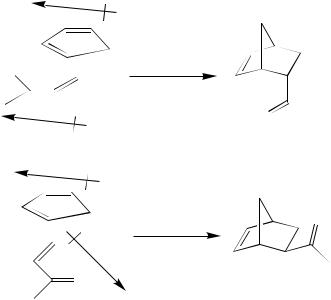
13. Catalysis of Diels–Alder reactions in water |
1053 |
O
O  endo
endo
O
exo
O
FIGURE 5. The different transition structure polarities, as indicated by the dipole arrows, of the Diels – Alder reaction
In summary, the interactions responsible for the typical solvent effects on Diels –Alder reactions are comparable to those of Lewis acids. The rate acceleration, the increase of regioselectivity and the higher endo/exo selectivity on changing the solvent may be explained by the FMO theory.
C. Hydrogen Bonding
1. Water
The classical description of a hydrogen bond begins with a pair of closed-shell molecules, both in their electronic ground state147. The interactions between a molecule AH containing a positively polarized hydrogen atom and another molecule containing a negatively polarized heteroatom X with at least one electron lone pair, mostly oxygen, nitrogen or fluorine, are summarized as hydrogen bonding. AH and X are not necessarily different molecules; intermolecular and intramolecular hydrogen bonds are also possible. Although in most cases AH and X are uncharged, one of the most important contributions to hydrogen bonding is electrostatics. The lone pair of the acceptor atom is ‘pulled’ towards the bridging proton to form a non-covalent bond. The strength of these hydrogen bonds reaches from 2 kcal mol 1 up to 15 kcal mol 1 for strongly hydrogen-bonded complexes like the ammonia– hydrogen fluoride complex148. The water dimer, which lies in between, will be used to describe the various components leading to hydrogen bonding. With the help of the Morokuma–Kitaura schemes149,150 it is possible, at least approximately151, to separate the different interactions (Table 10). This energy separation shows that the electrostatic interaction EES between the monomers is the most important. The other terms, the exchange energy EEX, the stabilization by polarization EPL and the charge transfer

1054 |
Alexander Wittkopp and Peter R. Schreiner |
|||
|
|
TABLE 10. Morokuma – Kitaura |
||
|
|
component analysis of the SCF |
||
|
|
interaction energy of the water dimera |
|
|
|
|
Morokuma – Kitaura |
Energy |
|
|
|
component |
|
|
|
|
|
|
|
|
|
EES |
7.5 |
|
|
|
EEX |
4.3 |
|
|
|
EPL |
0.5 |
|
|
|
ECT |
1.8 |
|
|
|
EMIX |
0.1 |
|
|
|
E |
5.6 |
|
a All values in kcal mol 1150 .
energy ECT, are normally less important. All remaining effects are collected in the last ‘mixing’ term, EMIX.
The component analysis demonstrates the importance of the electrostatic attraction for the stability of the water dimer, but it also emphasizes the significance of other interactions. In hydrogen-bonded complexes of molecules which are more easily polarizable than water, the polarization and the charge transfer energies may constitute a larger fraction of the total complexation energy. Hydrogen bonding is intimately involved in the structures and properties of water in its various phases, and of molecules in aqueous solution. In addition to the traditional role of the hydrogen bond as a structural element in large molecules such as proteins and nucleic acids152, a cooperative array of such bonds appears to be vital to the function of many enzymes153. There are some indications that hydrogen bonds play an even more important role in biological electron transfer across long distances than much stronger covalent bonds154. The principles of hydrogen-bond formation have been taken as a means to design new materials capable of self-assembly into well-ordered crystal structures155, for molecular recognition of organic molecules156 and for organic analogs of zeolites with supramolecular cavities and continuous channels157. Hydrogen bonding opens an avenue to stereocontrol of certain reactions158 and for understanding the structures of monolayers159. The most obvious effects of hydrogen bonding are the anomalous thermodynamic properties of water, which mostly derive directly from the unique molecular structure of liquid water and ice (Figure 6). Strong hydrogen bonds between the water molecules produce relatively stable clusters even in the liquid state. These lead to the high heat capacity, the large enthalpies of evaporation and solidification and the high surface tension of water. The water–water interactions can be influenced by solutes as well as by suspensed agents. This can lead to the unique solvent effects observed in organic transformations carried out in water or aqueous solutions.
Studies of such solvent effects on type (a) Diels –Alder reactions revealed that the reactivity was primarily determined by two solvent parameters: hydrogen-bond donating capacity and solvophobicity161. The interactions of water with the activating group of the dienophile in normal electron demand Diels –Alder reactions via hydrogen bonding strongly influence the reaction rate45,162. The correlation with the hydrogen-bond donating capacity strongly suggests that in water, a hydrogen-bond donating solvent par excellence, the Diels –Alder reaction benefits not only from hydrophobic but also from hydrogenbonding interactions. Several computations, including ab initio calculations and Monte Carlo simulations, as well as NMR studies showed that water is able to build up strong hydrogen bonds to Lewis-basic functional groups of organic compounds119,121,163.
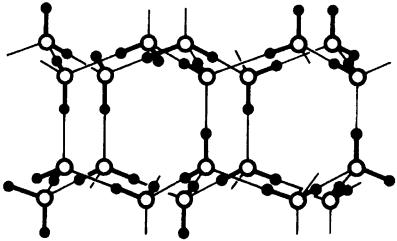
13. Catalysis of Diels–Alder reactions in water |
1055 |
FIGURE 6. The crystal structure of water, dominated by hydrogen bonds160
The interactions of hydrogen-bond donors and carbonyl groups are of particular interest, as these interactions often lead to effective H-bonding164,165. Furthermore, the small size of the water molecules allows efficient interaction with hydrogen-bond acceptors by forming more hydrogen bonds than in the case of larger protic organic solvents. This notion is supported by detailed kinetic studies on a number of carefully selected Diels –Alder reactions which showed that hydrogen bonds strengthen the electron-withdrawing capacity of the carbonyl functionality and thereby decrease the HOMO–LUMO gap between diene and dienophile.
By comparison of the reaction of cyclopentadiene with a carbonyl (Table 11, entry B) and a sulphonyl-containing substrate (Table 11, entry C), the effects of hydrogen bonding on the reaction rates were examined. The presence of the sulphur atom results in less effective hydrogen bonding and, in turn, in a smaller rate acceleration. The lower sensitivity of the sulphonyl compound in comparison with the carbonyl compound is demonstrated by a much less pronounced water-induced acceleration. Further proof for the importance of hydrogen-bonding interactions comes from the observation that the strong hydrogen-bond donor HFP also leads to impressive rate enhancements (Table 11, entries A, C, D, F)169 and that in case of weak hydrogen-bond acceptors the rate accelerations in water are somewhat smaller (Table 11, entry E)166.
2. Hydrogen-bonding additives
In an extension of these conclusions hydrogen-bonding additives can be of particularly great value in non-hydrogen-bonding solvents. Specific catalysts (Scheme 9, 7–10) are hydrogen-bond donors, which lead to rate accelerations and selectivity enhancements170. Only very few examples of non-aqueous hydrogen-bond donors in organic synthesis are known, but they open new avenues for developing such catalytic systems, perhaps to ultimately replace sometimes harmful Lewis acids.
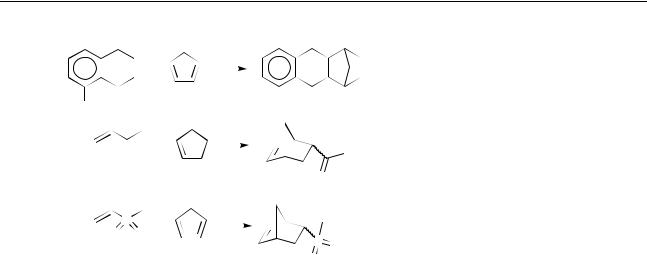
1056
TABLE 11. Relative rate constants of selected Diels – Alder reactions in water compared with organic solvents of different hydrogen-bond donor capacities
Entry |
|
|
|
|
|
|
Reaction |
|
Aprotic |
EtOH |
HFPa |
H2O |
Reference |
||||||||
A |
O |
|
|
|
|
|
|
|
|
|
O |
1 |
28.0 |
4320 |
12800 |
45 |
|||||
|
|
|
|
|
|
|
|
|
|
|
|
|
|
|
|
|
(hexane) |
|
|
|
|
|
|
|
|
|
|
|
+ |
|
|
|
|
|
|
|
|
|
|
|
|
|
|
|
|
|
|
|
|
|
|
|
|
|
|
|
|
|
|
|
|
|
|
|
|
|
|
|
|
|
|
|
|
|
|
|
|
|
|
|
|
|
|
|
|
|
|
|
|
|
|
|
|
|
|
|
|
|
|
|
|
|
|
|
|
|
|
||
|
|
|
|
|
|
|
|
|
|
|
|
|
|
|
|
|
|
|
|
|
|
OMe |
O |
|
|
|
|
|
|
|
|
|
OMe O |
|
|
|
|
|
|
|
|||
B |
|
|
|
|
|
|
+ |
|
|
|
|
|
|
|
|
1 |
4.79 |
100 |
290 |
45 |
|
|
|
|
|
|
|
|
|
|
|
|
|
|
|
||||||||
|
|
|
|
|
|
|
|
|
|
|
|
|
|
||||||||
|
|
|
|
O |
|
|
|
|
|
|
|
|
|
|
(CH3CN) |
|
|
|
|
||
|
|
|
|
|
|
|
|
|
|
|
|
|
|
|
O |
|
|
|
|
|
|
C |
|
|
|
S |
+ |
|
|
|
|
|
|
|
|
1 |
2.49 |
22.6 |
71.0 |
45 |
|||
|
|
|
|
|
|
|
|
|
|
|
|
|
(CH3CN) |
|
|
|
|
||||
|
O |
|
|
|
|
|
|
|
|
|
|
|
|
|
|
|
|
||||
|
|
|
|
O |
|
|
|
|
|
162 |
|||||||||||
|
|
|
|
|
|
|
|
|
|
|
|
|
|
|
S |
O |
|
|
|
||
|
|
|
|
|
|
|
|
|
|
|
|
|
|
|
|
|
|
|
|
||
O
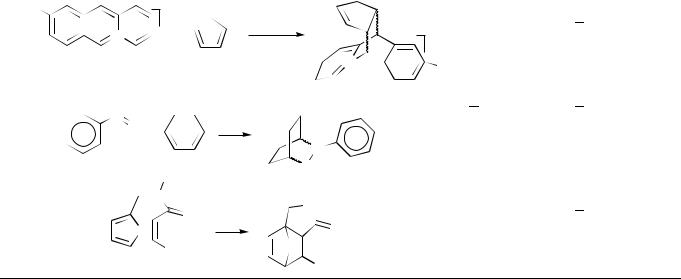
R |
|
|
+ |
|
(a) 1 |
|
|
|
D |
|
|
+ |
|
1.69 |
8.95 |
162 |
|
|
N |
|
+ |
(CH3CN) |
|
|
|
|
|
|
|
|
|
|
|||
|
|
|
Br− |
a: R = H |
|
|
|
|
|
|
|
b: R = OCOCH3 |
|
|
|
|
|
|
|
|
|
N |
R |
|
|
|
|
|
|
|
|
|
|
|
|
|
|
|
|
Br− |
|
|
|
|
|
N |
|
|
|
(b) |
1 |
102 |
166 |
|
|
|
|
|
|
|
|
|
E |
|
O |
+ |
|
1 |
1.14 |
5.49 44.3 |
167 |
|
|
|
||||||
|
|
|
|
N |
(toluene) |
|
|
|
|
|
|
|
O |
|
|
|
|
|
|
|
N |
N |
|
|
|
|
F |
|
|
O |
1 |
1.90 |
153 |
168 |
|
|
|
|
||||||
|
|
|
|
(hexane) |
|
|
|
|
|
|
|
O |
O |
|
|
|
|
|
|
|
|
|
|
|
||
|
|
|
CO2H |
O |
|
|
|
|
|
|
|
|
|
|
|
|
CO2H
a 1,1,1,3,3,3-Hexafluoro-2-propanol.
1057
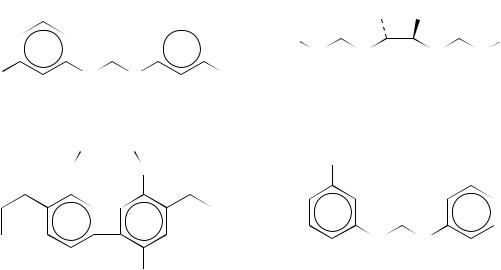
1058
|
CF3 |
|
|
|
|
CF3 |
|
|
|
|
|
|
|
|
|
|
|
|
|
|
|
|
|
|
|
|
|
|
|
|
|
S |
|
Ph |
|
|
Ph |
S |
|||||||
|
|
|
O |
|
Ph |
|
|
|
|
|
|
|
|
|
|
|
|
Ph |
||||
|
|
|
|
|
|
|
|
|
|
|
|
|
|
|
|
|
|
|
|
|||
|
|
|
|
|
|
|
|
N |
N |
|
|
|
N |
|
N |
|||||||
n-C8H17O2C |
N |
|
|
N |
CO2-n-C8H17 |
|
|
|
|
|
|
|
|
|
|
|
|
|
|
|
||
|
|
|
|
|
|
|
|
|
|
|
|
|
|
|||||||||
|
|
H |
Me |
|
|
|
Me |
|
H |
|||||||||||||
|
|
|
|
|
|
|
|
|
|
|
|
|
|
|
|
|
|
|
|
|
|
|
|
H |
|
|
H |
|
|
|
|
|
|
|
|
|
|
|
|
|
|
|
|
||
|
|
|
(7) |
|
|
|
|
|
|
|
|
|
(8) |
|
|
|
|
|
|
|||
|
H |
|
|
H |
|
|
|
|
|
|
|
|
|
|
|
|
|
|
|
|
||
|
O |
|
|
|
|
O |
|
CF3 |
|
|
|
|
|
|
|
|
|
CF3 |
||||
|
|
|
|
|
|
|
|
|
|
|
|
|
|
|
|
|
|
|
|
|||
|
|
|
|
|
|
|
|
|
|
|
|
|
|
|
S |
|
|
|
||||
|
|
|
|
|
|
|
|
|
|
|
|
|
N |
|
|
N |
|
|
|
|||
|
|
|
|
|
|
|
|
|
|
|
|
|
|
|
|
|
|
|||||
|
|
|
|
|
|
|
|
|
|
|
|
|
|
|
|
|
|
|
|
|
|
|
|
NO2 |
|
|
|
|
NO2 |
|
|
|
|
|
H |
|
|
H |
|
|
|
||||
|
|
|
|
|
|
|
|
|
|
|
|
|
|
|
|
|
|
|
|
|||
|
|
|
(9) |
|
|
|
|
|
|
|
|
|
(10) |
|
|
|
|
|
||||
SCHEME 9. Catalytically active hydrogen-bond donors
